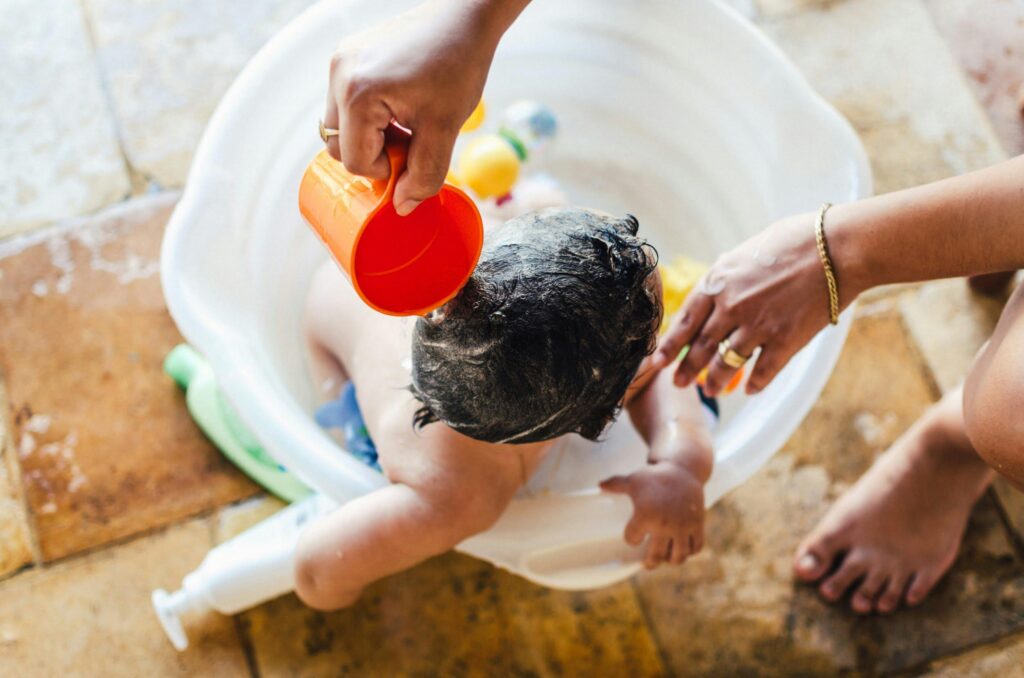As a mother of five who’s spent over two decades helping new parents as a midwife, I’ve witnessed countless bath time struggles and triumphs. The journey from those first delicate sponge baths to splashy tub adventures marks a significant milestone in your baby’s development. Today, I’m sharing my professional and personal wisdom on safely transitioning from sponge baths to tub baths—a process that should be both joyful and stress-free.
Understanding Baby Bath Basics
Every little one’s bath journey begins with gentle sponge baths. Those first weeks of parenthood are magical but overwhelming, and understanding when and how to transition from sponge baths to tub baths can add another layer of uncertainty. But don’t worry—I’ve guided hundreds of families through this transition, and with some patience and preparation, bath time can become a highlight of your day.
Why Sponge Baths Come First
When I brought home my first baby nearly 30 years ago, I remember being terrified of that first bath! Sponge baths aren’t just easier for nervous new parents—they serve important purposes:
- They protect the healing umbilical cord stump, which needs to stay dry
- They’re gentle on your newborn’s delicate skin
- They help maintain your baby’s body temperature more easily
- They provide a gradual introduction to the sensation of being cleaned
My oldest daughter would scream during those early sponge baths, eyes squeezed shut, tiny fists clenched. By baby number three, I’d become an expert at quick, efficient sponge baths that caused minimal distress. Bath time doesn’t have to be daily for newborns—2-3 times a week is plenty unless there’s a diaper explosion situation!
When to Transition from Sponge Baths to Tub Baths
The question of when to transition from sponge baths to tub baths depends on several factors, but there are some reliable guidelines I’ve shared with countless new parents over the years.
Physical Readiness Signs
Your baby is likely ready for tub baths when:
- The umbilical cord stump has fallen off completely and the area is fully healed (typically 1-2 weeks after birth)
- Any circumcision site has healed (usually 1-2 weeks)
- Your baby has good head control and neck strength
- Your little one weighs enough that they won’t get cold too quickly (usually around 10 pounds)
I remember when my fourth baby was born—he was a sturdy 9.5 pounds and had exceptional head control from day one. We were able to transition from sponge baths to tub baths earlier than with my previous children, at just barely three weeks old. Every baby is different!
Emotional Readiness for Tub Baths
Physical readiness is only part of the equation when determining when to transition from sponge baths to tub baths. Emotional readiness matters too:
- Your baby seems curious about water rather than fearful
- Sponge baths have become a positive experience
- Your baby seems to enjoy being in water during diaper changes or sponge baths
- YOU feel confident about handling a slippery baby in water
My second child was physically ready for tub baths at about 2 weeks old, but she would scream the moment water touched her skin. We continued with modified sponge baths for another two weeks, gradually introducing more water exposure until she became comfortable. Rushing the transition only creates stress for everyone involved.
How to Safely Transition from Sponge Baths to Tub Baths
Safety always comes first when it comes to transitioning from sponge baths to tub baths. As both a midwife and mother, I’ve seen that preparation is key to a smooth bath time experience.
Essential Safety Preparations
Before that first tub bath:
- Gather ALL supplies within arm’s reach before undressing baby
- Check water temperature with your wrist or elbow (it should feel warm, not hot—around 100°F/38°C)
- Fill the tub with only 2-3 inches of water
- Never, ever leave your baby unattended—not even for a second
- Have a warm towel ready for immediately after the bath
I’ll never forget helping my sister with her twins’ first tub bath. We had everything laid out like a hospital operating room—towels, clean clothes, diapers, lotion, and two sets of hands! Most importantly, we had our full attention on those babies every second.
Choosing the Right Bath Equipment
When transitioning from sponge baths to tub baths, having the right equipment makes all the difference:
- An infant tub with a newborn sling or built-in support
- A non-slip mat for additional security
- Soft washcloths designated just for baby
- Gentle, fragrance-free baby soap and shampoo
With my first baby, I used an expensive European baby tub with all the bells and whistles. By baby number five, I discovered that a simple plastic tub with a newborn insert worked just as well! The American Academy of Pediatrics offers excellent guidance on selecting safe bath equipment.
Step-by-Step Guide to the First Tub Bath
The transition from sponge baths to tub baths goes most smoothly when you follow a systematic approach. After helping countless new parents with this milestone, I’ve developed a foolproof method.
Before the Bath
- Choose a time when your baby is alert but not hungry or overly tired
- Warm the bathroom to prevent chilling
- Fill the tub with 2-3 inches of warm water before bringing baby into the bathroom
- Have one hand always on your baby while the other does the washing
My third baby was particularly sensitive to temperature changes. I learned to warm not just the bathroom but also the towels (by briefly running them through the dryer) before transitioning from sponge baths to tub baths.
During the First Tub Bath
When transitioning from sponge baths to tub baths, the first experience sets the tone:
- Start by gently placing baby’s feet in the water first
- Gradually lower their body while speaking soothingly
- Support their head and neck with one hand or arm at all times
- Use your free hand to gently splash water over their body
- Keep the first bath brief—3-5 minutes is plenty
With my youngest, I discovered singing made bath time magical. She would stop fussing immediately when I started singing “Rubber Duckie” from Sesame Street! Find what works for your baby—talking, singing, or making funny faces can all help ease the transition.
Common Challenges When Transitioning to Tub Baths
Even with perfect preparation, the transition from sponge baths to tub baths may present challenges. After supporting thousands of families through this process, I’ve seen it all!
Fear of Water
If your baby seems fearful:
- Start with very shallow water
- Wrap them in a thin cotton blanket and gradually immerse it
- Consider a “lap bath” where you sit in the tub holding baby
- Keep eye contact and maintain a calm, happy demeanor
My first daughter was terrified of water until we tried the blanket method. The familiar feeling of being wrapped helped her accept the new sensation of the water around her body.
Temperature Sensitivities
Some babies are extremely sensitive to water temperature when transitioning from sponge baths to tub baths:
- Invest in a reliable bath thermometer
- Consider filling the tub with slightly warmer water (101-102°F) as it will cool during the bath
- Keep the bathroom extra warm
- Have a hooded towel ready for immediate wrapping
According to research from the National Association of Neonatal Nurses, maintaining proper temperature during bath time helps babies feel secure and reduces stress hormones.
Making Bath Time Educational and Fun
Once your baby has successfully transitioned from sponge baths to tub baths, it becomes an opportunity for learning and bonding.
Developmental Play During Bath Time
Bath time offers rich sensory experiences:
- Describe what you’re doing (“Now I’m washing your little fingers!”)
- Name body parts as you wash them
- Introduce cause and effect with gentle splashing
- Add simple, safe toys as your baby grows
By my fifth baby, bath time had evolved into a sensory playground. We had special bath books, color-changing bath drops, and songs for each part of the routine. The transition from sponge baths to tub baths opens the door to these enriching experiences.
Establishing a Relaxing Routine
A consistent bath routine can signal to your baby that sleep time is approaching:
- Try to bathe at approximately the same time each day
- Use the same sequence of actions
- Consider adding lavender-infused products for older babies (6+ months)
- Follow with gentle massage and quiet time
For my second son, who struggled with sleep, the transition from sponge baths to tub baths became our nightly sleep cue. The warm water, followed by massage with lotion and soft pajamas, helped signal his body that rest was coming.
When to Consult a Healthcare Provider
While transitioning from sponge baths to tub baths is typically straightforward, there are situations where professional guidance helps.
Signs Something Isn’t Right
Contact your pediatrician if:
- Your baby seems extremely distressed by water even after multiple gentle attempts
- You notice skin reactions after bathing
- The belly button area shows signs of infection (redness, odor, discharge)
- Your baby seems unusually cold or lethargic after baths
With my fourth baby, I noticed that his skin became very dry and red after our first few tub baths. As both a mother and midwife, I recognized the signs of sensitive skin and switched to a fragrance-free, hypoallergenic soap recommended specifically for eczema-prone skin.
Beyond the Basics: Bath Time as a Bonding Opportunity
The transition from sponge baths to tub baths opens wonderful opportunities for parent-child bonding. Those precious minutes of undivided attention create lasting connections.
Creating Special Memories
Some of my favorite parenting memories come from bath time:
- The first time my babies discovered they could splash
- Watching them discover their toes in the water
- The pure joy on their faces when they realized bath time could be fun
- Those sweet after-bath snuggles in a warm towel
As a midwife, I’ve heard countless parents share similar stories. The transition from sponge baths to tub baths marks the beginning of a new chapter filled with joyful, watery adventures.
Conclusion: Embracing the Bath Time Journey
The transition from sponge baths to tub baths represents just one of many milestones you’ll experience with your little one. Like everything in parenting, it works best when approached with flexibility, patience, and love. Remember that your baby will give you cues about their readiness—watch for them and respond accordingly.
As both a mother who’s bathed five babies and a midwife who’s guided hundreds more families through this transition, I can promise you this: what seems overwhelming now will soon become second nature. Before long, you’ll be an expert on your baby’s bath time preferences and needs.
Treasure these moments of splashing, singing, and bonding—they create the foundation for a lifetime of positive hygiene habits and, more importantly, beautiful memories of care and connection between you and your child.



